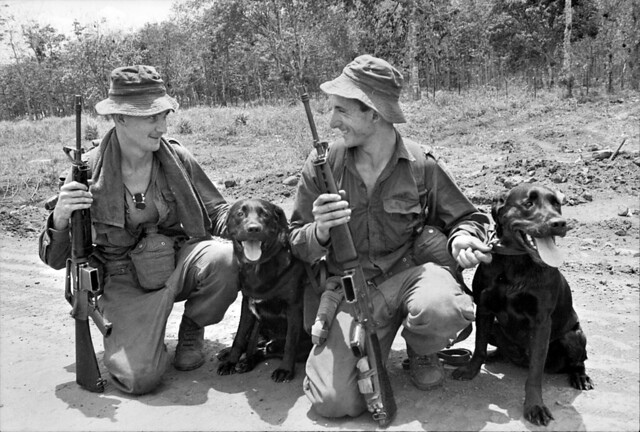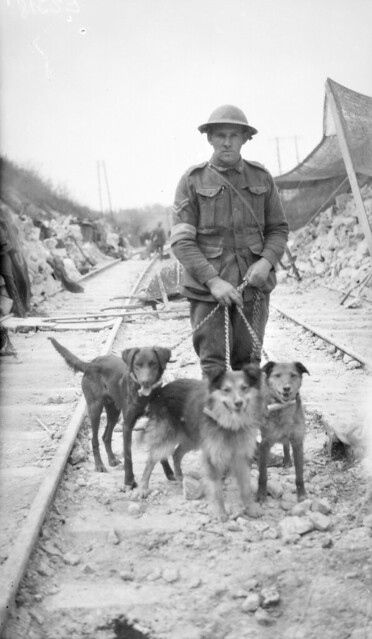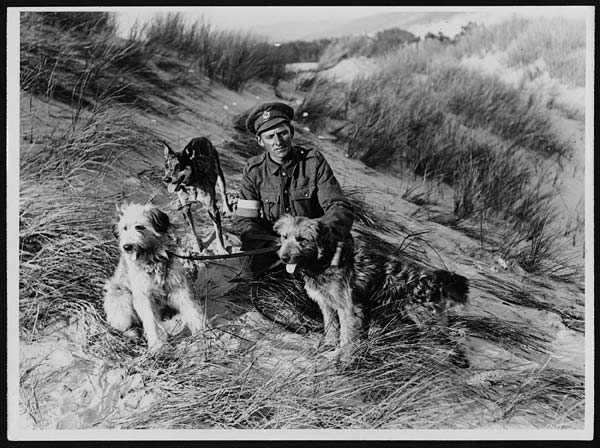(Click on a photo to go learn more)

Huskies pulling sledge in the first Australasian Antarctic Expedition, 1911-1914

Tracker dogs and handlers, 1967. Used to sniff out Viet Cong fighters during the Vietnam war.

The caption reads, in part:
"Informal portrait of 3133 Corporal James Coull with dogs of No. 3 Messenger Dog Section. Left to right: War Dog 103 Nell, a Cross Setter; 102 Trick, a Collie; 101 Buller (sometimes referred to as Bullet), an Airedale. All three dogs were very efficient in message carrying and saw service with the 2nd, 4th and 5th Australian Divisions, also with Divisions of the British 8th Corps (Imperial). 102 Trick was particularly efficient and was well known by all Brigades of abovenamed Divisions. He was specially mentioned by Signal Officer of 2nd Division for good work at Rubimont, near Heilly"
Remember how last post I was saying how Brave Dog stories choked me up? Yeah. The description of the duties of messenger dogs in WWI does that to me.
Here's another photo of a trio of dogs with their handler, with another interesting description.

"Informal portrait of 3133 Corporal James Coull with dogs of No. 3 Messenger Dog Section. Left to right: War Dog 103 Nell, a Cross Setter; 102 Trick, a Collie; 101 Buller (sometimes referred to as Bullet), an Airedale. All three dogs were very efficient in message carrying and saw service with the 2nd, 4th and 5th Australian Divisions, also with Divisions of the British 8th Corps (Imperial). 102 Trick was particularly efficient and was well known by all Brigades of abovenamed Divisions. He was specially mentioned by Signal Officer of 2nd Division for good work at Rubimont, near Heilly"
Remember how last post I was saying how Brave Dog stories choked me up? Yeah. The description of the duties of messenger dogs in WWI does that to me.
Here's another photo of a trio of dogs with their handler, with another interesting description.

"A British soldier holds three dogs which were trained to carry messages between the lines and command during World War I. Usually the dogs had been strays, so one particular breed of dog could be not preferred. Generally, however, traditional working breeds, such as collies, retrievers, or large terriers, were chosen for messenger work. Messenger dogs were based in sectional kennels near the front lines. On average each sectional kennel had 48 dogs and 16 handlers, a ratio that indicates how important the dogs' work was at the front. Before being shipped to France the dogs were trained at the War Dog Training school in Shoeburyness."

4 comments:
That cross setter looks angry to me :).
What a great resource.
There was a documentary on the Vietnam war dogs that ran on the Discovery channel many years ago. I sat on the couch and just bawled.
Hoyden here.
I really really like this post. I love reading about war dogs and seeing pictures of them.
My dog and I did a therapy visit with a WWII veteran last week that was CONVINCED that my seal colored pit bull was the doberman that he handled in Guadalcanal. He told us that his dog sniffed out the "nips" hiding in holes.
The man had a stroke, so he's a little bit confused about things, but it was the first time he talked about his WWII experiences to any of his family.
Hi Hoyden, yes, I love war dog stories/photos too.
Dog Spelled forward just had a similar story to yours:
http://www.dogspelledforward.com/what-our-pets-mean-to-us
It's amazing what dogs can do for people.
Post a Comment